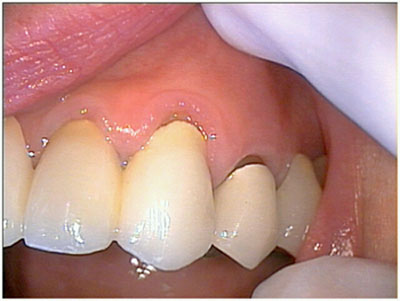Does Loose Abutment Need Endo?
This patient was referred to me for endodontic consideration of the maxillary left cuspid area. The patient had been complaining of diffuse toothache and sensitivity to liquids. The tooth was part a multi-unit fixed prosthesis. The referring dentist asked me to perform endodontic treatment on through cuspid crown because of the presence of the thermal sensitivity.

Periapical radiography showed no evidence of pathology. When cold liquids were applied to the crown margin by irrigation syringe, the patient reacted positively.
Closer examination of the crown margins revealed discrepancy in the crown fit. At that point I managed to get the tip of an explorer under the palatal crown margin and wedge it between the crown margin and the root. I then applied occusal pressure to the prosthesis with my fingers and closely observed the labial crown margin. This is what happened:

The abutment tooth ( #23) had become loose from the bridge. Rather than treat the tooth endodontically, the patient was referred back to her dentist for bridge removal and cementation. In this case there was no obvious decay and it seemed that the cement had washed out from under the crown. the bridge was recemented and the patient’s symptoms disappeared.
Why is this significant? Because there is a natural tendency for clinicians to want to endodontically treat cases such as these. This eliminates the thermal and liquid sensitivity and relieves the patient’s symptoms. However, it does not address the true problem- the loose abutment. Had I simply treated the case and NOT initially recommended removal/inspection/recementation of the bridge, it is likely that the the endodontic treatment would have eventually be compromised by the leaking crown margins. It is also likely that the crown preparation would have decayed from inside the crown and this critical abutment may have been compromised or eventually lost.
Conclusion
Endodontic treatment is often recommended when crowned teeth are sensitive to thermal stimulus. The best way to prevent this situation is to consider elective endodontic treatment BEFORE the fixed prosthesis is cemented. Teeth with large restorations, fillings close to the pulp, pulp caps, history of multiple crown cementations or preparations close to pulp horns all can result in post cementation thermal sensitivity. Elective endodontic treatment in selected cases can result in better results because the clinician is no longer “afraid” of the consequences of pulpitis. It also allows for the creation of a more “classic” preparation when you are not concerned with the depth of preparation vis a vis the pulp.
BUT we should also remember that the symptoms of a loose prosthesis can also mimic these problems. It is important to closely examine all abutments to make sure that they are not loose. Simply devitalizing a tooth with no regard to the quality of the crown margin can lead to eventual catastrophic failure of the abutment through caries, endodontic failure and possible loss of the tooth.
